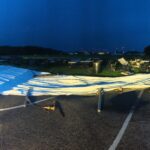On Tuesday, July 16, 2024 the Purdue Turf Program, the Purdue Green Industry Working Group and the Midwest Regional Turf Foundation successfully hosted the Purdue Turf and Landscape Field Day. The day didn’t start off as we had planned as our tent, capable of seating 500 people, was destroyed overnight in a severe storm. However,[Read More…]
Over the past week I have identified three different fowl bluegrass (Poa palustris) samples sent in to the Purdue Plant & Pest Diagnostic Lab (https://ag.purdue.edu/department/btny/ppdl/). This is not concerning, just unusual. This is not a grass species that I see that often, but I have seen several samples this year, including a sample from my[Read More…]
Biology: Pineapple weed (Matricaria matricariodies), behaves as either a summer or winter annual and it is commonly found throughout the United States. It is a weed of both high- and low-maintenance turfgrass lawns, landscapes, and nursery crops. Its ability to tolerate low mowing heights and highly compacted soils allow pineapple weed to compete with in weak[Read More…]
Biology: Common bermudagrass (Cynodon dactylon) is the most commonly used turfgrass in the southern United States, but it is also a difficult-to-control weed in northern turf. Bermudagrass is a drought tolerant, warm-season, perennial grass species that tolerates low mowing and actively spreads vegetatively by both rhizomes and stolons but also has the ability to spread by[Read More…]
Biology: Prostrate Spurge (Euphorbia humistrata) is a summer annual broadleaf weed that can be found in dry/sandy and/or nutrient-poor soils along with compacted, weakened or disturbed turfgrass and landscape sites. Look for it first in driveways and sidewalks or in potted plants in a landscape or nursery as temperatures start to get warmer. Prostrate spurge can also[Read More…]
Day-to-day activities have changed every aspect of businesses throughout the country. The Green Industry is no exception, with changes implemented to maintain safe working environments for employees and their clients while being compliant with the state’s Executive Order. Due to the diversity of services and products that the Green Industry provides, there is no one-size-fits-all[Read More…]
Biology: Wild Garlic (Allium vineale) is a monocotyledonous cool-season perennial that can be found throughout most of the eastern and southern United States. Despite having linear leaves and parallel veins, wild garlic is neither a grass nor a sedge; it is a member of the lily family. Wild garlic is more noticeable in the winter and[Read More…]
Biology: Common mallow (Malva neglecta), also known as cheese mallow, cheese weed, and dwarf mallow, is a winter annual broadleaf weed, though it can also act as a biennial if environmental conditions that favor growth persist. It is generally found in low-maintenance turfgrass lawns, nursery crops, and landscapes. The ability of common mallow to survive in[Read More…]
Biology: Ground ivy (Glechoma hederacea), also known as creeping Charlie, is a very difficult to control perennial broadleaf weed. It can often be seen growing in the shade and invading turfgrass and landscapes throughout the United States. Ground ivy thrives in moist, rich soils located in shaded areas, but will grow in full sun as well.[Read More…]
Biology: Purple deadnettle (Lamium purpureum) is a common winter annual broadleaf weed found throughout the US. It is closely related to another winter annual broadleaf, henbit (Lamium amplexicaule). Both have vibrant purple flowers that can been seen now in lawns, landscapes, and fields. To see more about henbit, refer to this article from last spring: https://purduelandscapereport.org///article/spotlight-on-weeds-henbit-lamium-amplexicaule/[Read More…]
Biology: Common chickweed (Stellaria media) is a winter annual broadleaf weed. In lawns, it forms dense, prostrate patches throughout North America, but can grow relatively tall in the landscape. Common chickweed germinates from seed in late summer or early fall. However, germination timings can vary throughout the year if conditions are shady, and moist enough. Identification: Common[Read More…]
Biology: Yellow nutsedge (Cyperus esculentus), also known as chufa (chufa is a non-weedy variety that is used for wildlife food plots and is not a cold hardy weed like yellow nutsedge), nutgrass, or watergrass, is a troublesome, difficult-to-control perennial weed found throughout the United States. It is important to understand that yellow nutsedge is not a grass[Read More…]
Biology: Broadleaf plantain (Plantago major) is a perennial, broadleaf weed that can be found in nutrient-poor soils; however, they prefer nutrient rich-soils that are moist and often high in calcium. Broadleaf plantain is a common weed in turfgrass, nurseries, and landscapes. It germinates from seed in late spring through mid-to-late summer and occasionally in the[Read More…]
Biology: Henbit (Lamium amplexicaule) is a common winter annual broadleaf weed found throughout the United States. It can often be mistaken for another closely related winter annual broadleaf, purple deadnettle. Both can be observed by their showy pink to purple flowers which are primarily produced in April, but can appear from March to November in Indiana.[Read More…]














